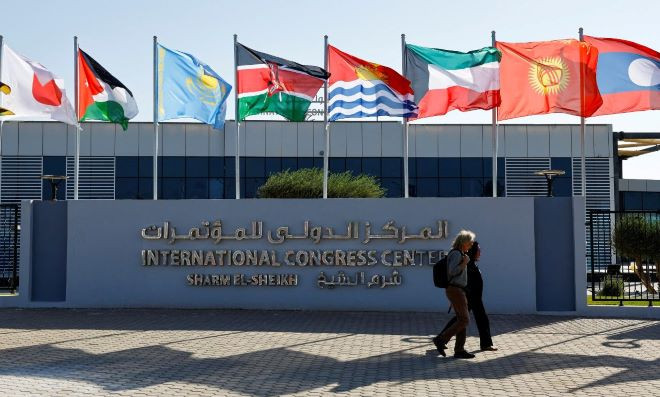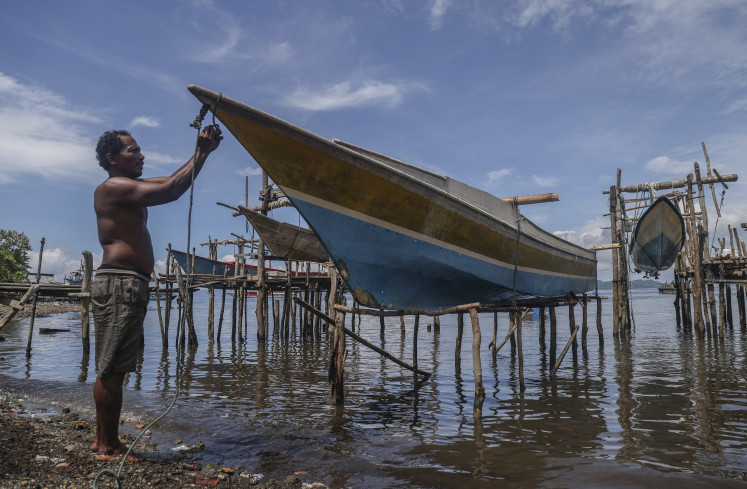Popular Reads
Top Results
Can't find what you're looking for?
View all search resultsPopular Reads
Top Results
Can't find what you're looking for?
View all search resultsHow will Indonesia balance economic growth with its green transition?
In 2021 alone, Indonesia cut 10.37 million tons of carbon dioxide from its energy plants, representing 210.8 percent of its initial target.
Change text size
Gift Premium Articles
to Anyone
W
hen it comes to climate change, Asia is a place of paradox: home to many of the most vulnerable regions to extreme heat, flash floods, and sea level rise, it also contains some of the world’s largest greenhouse gas emitters. Last year alone, over 57 million people across the continent were impacted by extreme weather events, leading to dire consequences, be it community displacement, long-term health effects, reduced access to food and water, or even loss of income.
The threat of climate change can no longer be viewed in a vacuum — the interrelated causes and effects are what have made it so challenging to create the right structures, invest finance, and refocus efforts toward meaningful climate action. These challenges are now taking place against the backdrop of a souring macroeconomic environment along with a worldwide energy crisis, all of which only serve to exacerbate the sociopolitical challenges facing policymakers.
As all the world’s attention turns once again to the 2022 United Nations Climate Change Conference (COP27), how can some of the region’s economic powerhouses, like Indonesia, best balance economic growth with their green transition?
Renowned as one of the world’s leading biodiversity hotspots and home to up to 15 percent of the planet’s known plants, mammals, and birds, Indonesia is undoubtedly a green gem in the region. For the past few years, the government’s forward-thinking climate policy initiatives have made truly meaningful strides in strengthening its sustainability commitments.
Indonesia was recognized as one of the few countries at last year’s UN climate conference (COP26) on track to eliminate deforestation by 2023, with rates of forest loss decreasing consistently for the past five years. This has been bolstered by a new climate deal in which Norway will support Indonesia with US$56 million to reduce its domestic deforestation as part of Indonesia’s commitment to its (Forestry and Other Land Use (FOLU) Net Sink 2030 Operational Plan.
Along with its protection of carbon sinks, Indonesia is also keeping up with peers in the region such as Singapore, as is among 61 countries with established carbon pricing regulations, committing to reduce its greenhouse gas emissions by approximately 32 percent on its own or by 43 percent if bolstered by international support by 2023 — a markedly ambitious emission reduction target. In 2021 alone, Indonesia cut 10.37 million tons of carbon dioxide from its energy plants, representing 210.8 percent of its initial target. For Indonesia, further reductions could manifest through green financing opportunities or with new technologies.
But it’s not all roses — the ongoing energy crisis has forced Indonesia to delay its carbon taxation scheme. This setback is significant, as revenues from the scheme could have been redirected toward renewables. Even once the scheme comes to fruition, regulators will need to factor in rising inflation and its impact on the affordability of electricity prices — purportedly why the proposed carbon tax rate was criticized for being too low to discourage the continued use of coal.
However, the 43 percent reduction target is still within reach. One such way that Indonesia can finance its green transition is by opening up the cross-border trade of carbon credits. As Indonesia’s finance minister Sri Mulyani Indrawati pointed out at July’s G20 event, Indonesia’s FOLU sector has generated a carbon credit export potential of US$172.6 million this year, showing that the value of carbon trading capabilities most certainly has financial incentives. This capital can not only be directed toward regenerative projects — be it reforestation or carbon sequestration — but also to support communities most vulnerable to the impacts of climate change.
Yet in spite of this progress, new threats are looming. Foreign direct investments (FDIs) in the country are seeing record highs, growing by 63.6 percent in the third quarter compared to the year before due to the government’s current commodities downstreaming policy. With more firms setting up shop domestically to refine metals onshore such as nickel and bauxite, this has naturally led to new job creation opportunities but also significant environmental degradation.
Like many emerging markets, Indonesia has a conundrum on its hands — meeting its nationally-determined contributions and the need to spur economic growth. However, one such way to mitigate the impact of these new industries is for the country to develop its own carbon trading facility — and this doesn’t seem too far off into the future.
In recognition of the role that new technologies can play in strengthening climate initiatives, the Indonesia Stock Exchange announced that it would be entering into an exploratory partnership with green fintech MVGX this month to launch its own carbon trading facilities which can go a long way in enabling Indonesia to leverage international capital, access new pathways for FDIs while meeting its net-zero targets as 2030 approaches.
Encouraged by Article 6 of the Paris Agreement which stipulates that countries can tap into international cooperation to meet their nationally-determined contributions (NDCs), voluntary carbon markets serve as a vital accelerant in strengthening a country’s climate ambitions.
However, VCMs continue to face critical issues, specifically as it pertains to standardization and comprehensive regulatory frameworks that can be applied at scale. To address this, partnering with the right technological infrastructure provider that can ensure data integrity and veracity in measurement, all according to globally-recognized standards, such as the Clean Development Mechanism, Gold Standard, or Verra standard for carbon credit verification, ISO 14064-1:2018 for carbon footprint verification, and PAS 2060 for carbon neutrality verification.
Meanwhile, carbon nationality issues and double-counting also threaten the viability of VCMs. Double counting takes place when an organization in the host country and a buyer organization in the buyer country offset their emissions simultaneously and the host country of the sustainability project that is trying to reach its nationally determined contribution (NDC) targets under the Paris Agreement, lay claim to the same climate action. With digital carbon credits this can be avoided as both the seller and buyer of the credits will have a full view of carbon footprint disclosures as they are independently verified and tracked on the blockchain, to prevent double-counting.
It’s through trustworthy and transparent systems such as these that will help to ensure that all voluntary emission reductions listed on the carbon trading facility are recognized by other jurisdictions as high-integrity, standards-abiding credits. This not only empowers investors seeking to green their portfolios, but is also crucial for domestic producers looking to offset their carbon expenditure before exporting their goods to trading zones such as the European Union which place carbon taxation obligations on any goods entering the bloc.
As Indonesia looks to 2030, now nearly only seven years away, it has a great deal to be proud of, but more work still needs to be done. While cutting emissions altogether should be the absolute end goal, curbing emissions is still a valid place to begin especially for high-polluting industries.
With a myriad of opportunities for regional and international collaboration, it’s clear that voluntary carbon markets are set to play an outsized role in facilitating Indonesia’s green transition.
***
The writer is executive chairman and co-Founder of MVGX.











